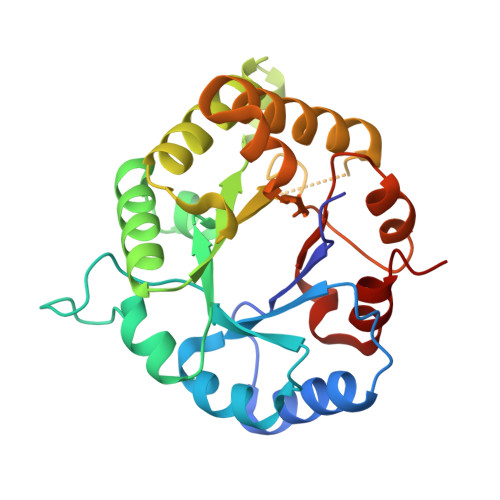Structural and biochemical characterization of a recombinant triosephosphate isomerase from Rhipicephalus (Boophilus) microplus.
Moraes, J., Arreola, R., Cabrera, N., Saramago, L., Freitas, D., Masuda, A., da Silva Vaz, I., Tuena de Gomez-Puyou, M., Perez-Montfort, R., Gomez-Puyou, A., Logullo, C.(2011) Insect Biochem Mol Biol 41: 400-409
- PubMed: 21396445
- DOI: https://doi.org/10.1016/j.ibmb.2011.02.009
- Primary Citation of Related Structures:
3TH6 - PubMed Abstract:
Triosephosphate isomerase (TIM) is an enzyme with a role in glycolysis and gluconeogenesis by catalyzing the interconversion between glyceraldehyde 3-phosphate and dihydroxyacetone phosphate. This enzyme has been used as a target in endoparasite drug development. In this work we cloned, expressed, purified and studied kinetic and structural characteristics of TIM from tick embryos, Rhipicephalus (Boophilus) microplus (BmTIM). The Km and Vmax of the recombinant BmTIM with glyceraldehyde 3-phosphate as substrate, were 0.47 mM and 6031 μmol min⁻¹ mg protein⁻¹, respectively. The resolution of the diffracted crystal was estimated to be 2.4 Å and the overall data showed that BmTIM is similar to other reported dimeric TIMs. However, we found that, in comparison to other TIMs, BmTIM has the highest content of cysteine residues (nine cysteine residues per monomer). Only two cysteines could make disulfide bonds in monomers of BmTIM. Furthermore, BmTIM was highly sensitive to the action of the thiol reagents dithionitrobenzoic acid and methyl methane thiosulfonate, suggesting that there are five cysteines exposed in each dimer and that these residues could be employed in the development of species-specific inhibitors.
- Laboratório de Química e Função de Proteínas e Peptídeos and Unidade de Experimentação Animal-RJ, CBB, UENF, Avenida Alberto Lamego 2000, Horto, Campos dos Goytacazes, RJ, CEP 28015-620, Brazil.
Organizational Affiliation:
















